Hockey’s great shot volume debate

There’s a lively debate brewing within the hockey analytics community that almost rises to the level of a family feud.
Old school pundits may have come around to the idea that the number of shot attempts a player generates tells us something meaningful about his true abilities and that in a small number of games this information is more useful than traditional measures such as goals, assists and points.
But whether counting shots is enough—or whether the quality of those shots also needs to be measured—is much more controversial.
There’s no doubt some shots, such as breakaways, are more likely to result in goals than others.
The debate is whether certain players, or even teams, are able to consistently generate higher quality shots or if things all even out over time and everyone’s shot quality regresses toward some league average.
What’s at stake here is whether teams or players should be judged solely on the number of shot attempts they generate (and give up), or whether a consistent ability to generate higher quality shots allows a team to continue to win even if it loses the possession battle on each given night.
The Anaheim Ducks and Montreal Canadiens— two teams that are heading in opposite directions right now—can help us see why at least one aspect of shot quality, as measured by the ability to get shots on net, matters a great deal.
Shot quality in 200 words or less …
Despite some interesting efforts to categorize some shot attempts as better than others, there really isn’t a widely accepted definition of what shot quality is.
For example, War-on-Ice.com gave us the “high danger scoring chance” and the folks at hockey-graphs.com have looked at the relationship between passing and pre-shot movement that can catch a goalie off guard.
Neither of these concepts come close to capturing the many different circumstances (e.g. traffic in front of the net, rebounds, shot location, etc.) that make one shot better than another, but what they have in common is that they look at something that happens before the puck is released.
By looking at whether or not a puck makes it to the net, we’re examining something we learn after the puck leaves the stick.
And yet, if putting shots attempts on net makes a team more likely to succeed, then on average the shots that do make it to the net must be more valuable (i.e. higher quality) than those that do not.
In other words, putting pucks on net provides indirect evidence of what can only be described as higher quality shooting.
Habs deliver on early season promise
Just how good are the 2015-16 Montreal Canadiens?
Back in October we made a prediction that was both obvious and certain to be unpopular among Montreal fans (see link on left).
Yes we were picking low hanging fruit by acknowledging that either an injury or anything less than a Hart Trophy-winning season from goaltender Carey Price would severely damage the Canadiens’ prospects of making the playoffs and doing some damage while they’re there.
But we also questioned whether the team’s skaters would sustain their excellent early season performance or if there was some smoke and mirrors involved in Michel Therrien’s alleged off-season transformation into a coach who had “seen the light” and changed his system in order to win in a sustainable way (i.e. by maximizing shot attempts).
Of course, Price did get injured and the Canadiens have been in a tailspin ever since: After their 9-0 start, they’ve posted a record of 15-24-4 and are now five spots away from a wild card berth with no fixed date for Price’s return.
It appears this decline was inevitable, and it’s not just bad goaltending at work here either.
Ordinarily when someone who is doing hockey analytics makes a statement like that, you might assume they’ll then tell you the team in question is on the wrong side of the puck possession numbers.
Not this time.
At the 10-game mark, Montreal posted a score-adjusted shot attempt percentage (SASAT%) of 52.1%, good for sixth in the league (data courtesy of puckon.net). This was a team that was blowing out opponents by controlling play and letting Price work his magic when the puck came his way.
During the 10 games leading up to the All Star break, in which they posted a 2-7-1 record, the Canadiens’SASAT% improved significantly to 54.3% (fifth).
It would be easy for fans to write the losses off as bad “puck luck,” but if they’re waiting for the tide to turn and the solid possession numbers to become wins, they will be waiting a long time.
As the charts below show (data courtesy of War-on-Ice.com), the Habs were doing a terrific job of getting pucks on their opponent’s net early in the season. During the 10 games before the All Star break, they were firing away to less avail. They actually missed the net less often but got blocked way more, with far fewer shot attempts getting to their intended target.
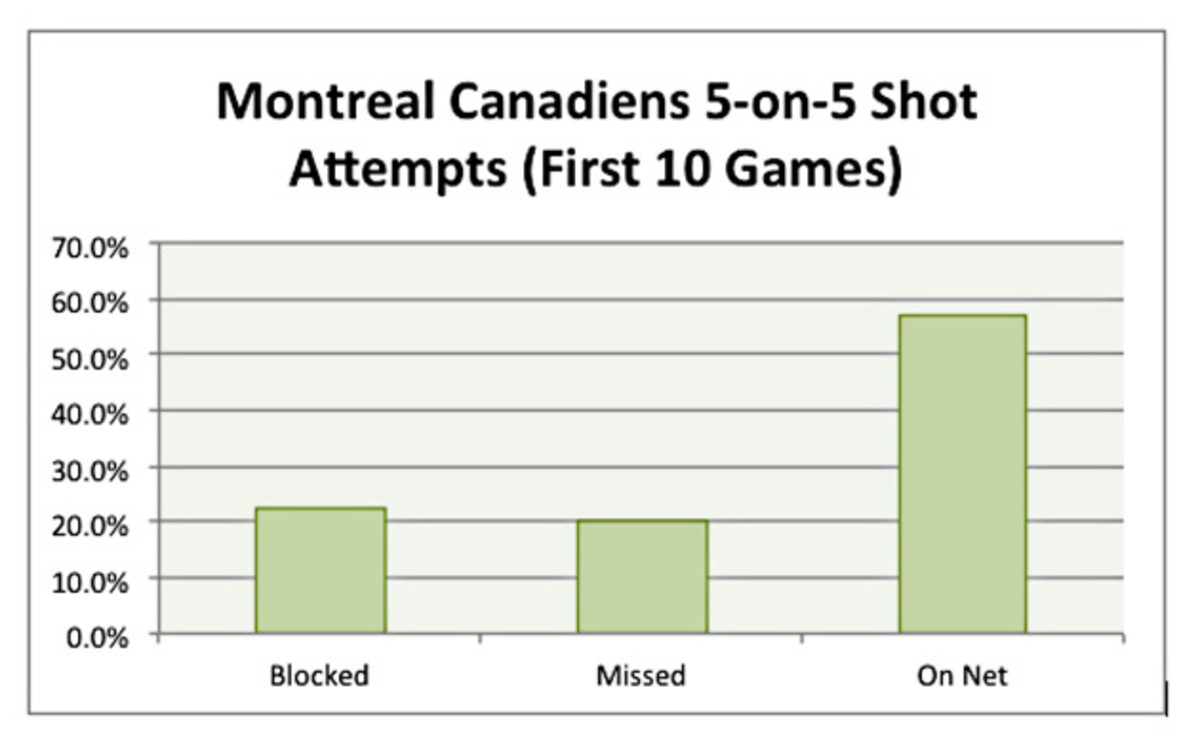
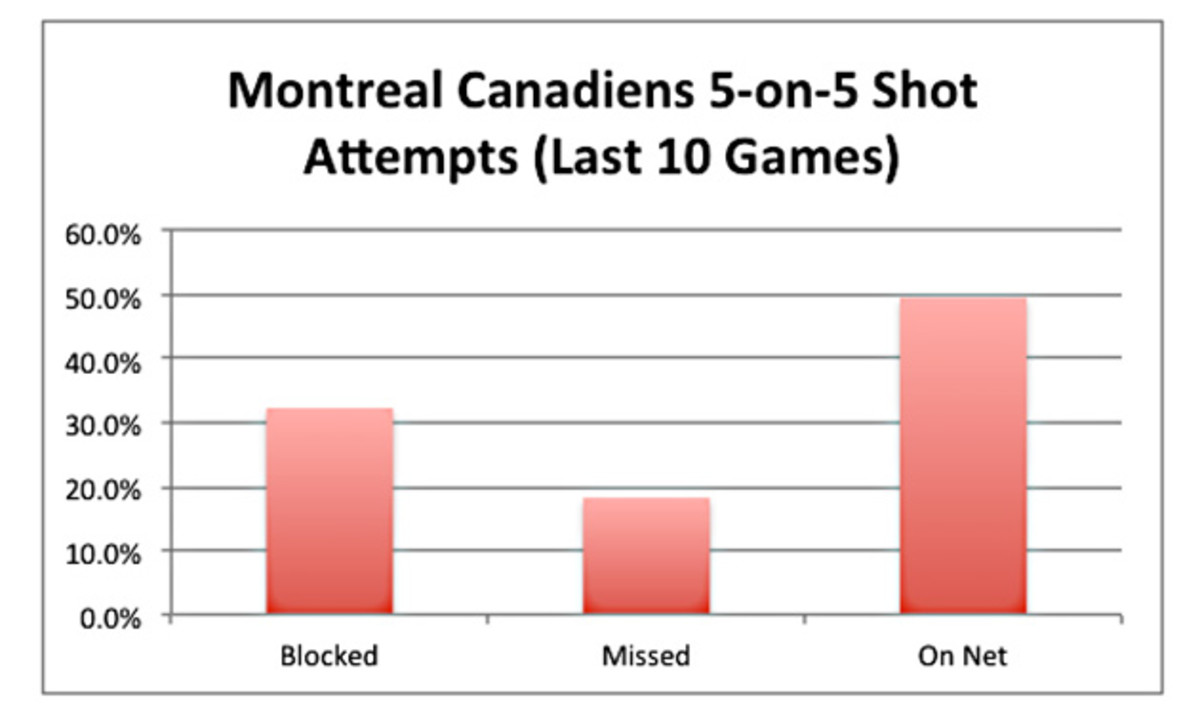
What’s going on here isn’t an accident. As Sportsnet commentator Elliotte Friedman has noted both on air and in print, during their journey down the standings, the Habs were slowly drifting away from the inner slot when shooting the puck.
Put simply, the team hasn’t been getting pucks on net because it is shooting from less choice locations.
The Return of the Mighty Ducks
Until this season the Ducks have been successful by being pretty much the opposite of the Canadiens. While the Habs relied primarily on stellar goaltending to remain competitive, the Ducks generally had mediocre goaltending and off the charts shooting.
Last season we predicted an early playoff exit for the Ducks because we thought their success was unsustainable.
As it turned out, we were wrong: the Ducks had a nice run and took the eventual Stanley Cup champion Blackhawks to seven games in the Western Conference Finals.
This season the proverbial chickens came home to roost.
A team that topped many pundits’ lists of Cup favorites limped out to a 1-7-2 start in which Anaheim averaged one goal per game.
In comedy bit, Ference thanks hockey fans for telling him to shoot
You might think you’ve seen this movie before: It’s called the 2013-14 Colorado Avalanche, which had horrid possession numbers but finished third in the league based on magic in one-goal games only to plummet the next season, or the 2014-15 Calgary Flames, who were possession lightweights but managed to go two rounds in the playoffs before taking their rightful place as contenders in the Auston Matthews sweepstakes this year.
While the Ducks may have their shortcomings, they’re not the Avalanche or the Flames.
In its first 10 games this season, Anaheim went from last season’s mediocre possession team (SASAT of 51.1%, 15th overall) to bad but not quite horrific (47.9%, 23rd).
The team improved immensely during its 7-3-0 stretch up to the All Star break to 54.4% (4th).
There’s no doubt the Ducks are playing better hockey, but puck possession doesn’t tell the full story. Once again, there’s a shot quality story to tell, and once again part of that story has to do with getting pucks on net.
During their recent turnaround the Ducks went from putting less than half their shots on net (and nearly one-third were blocked) to an impressive 55.3%.
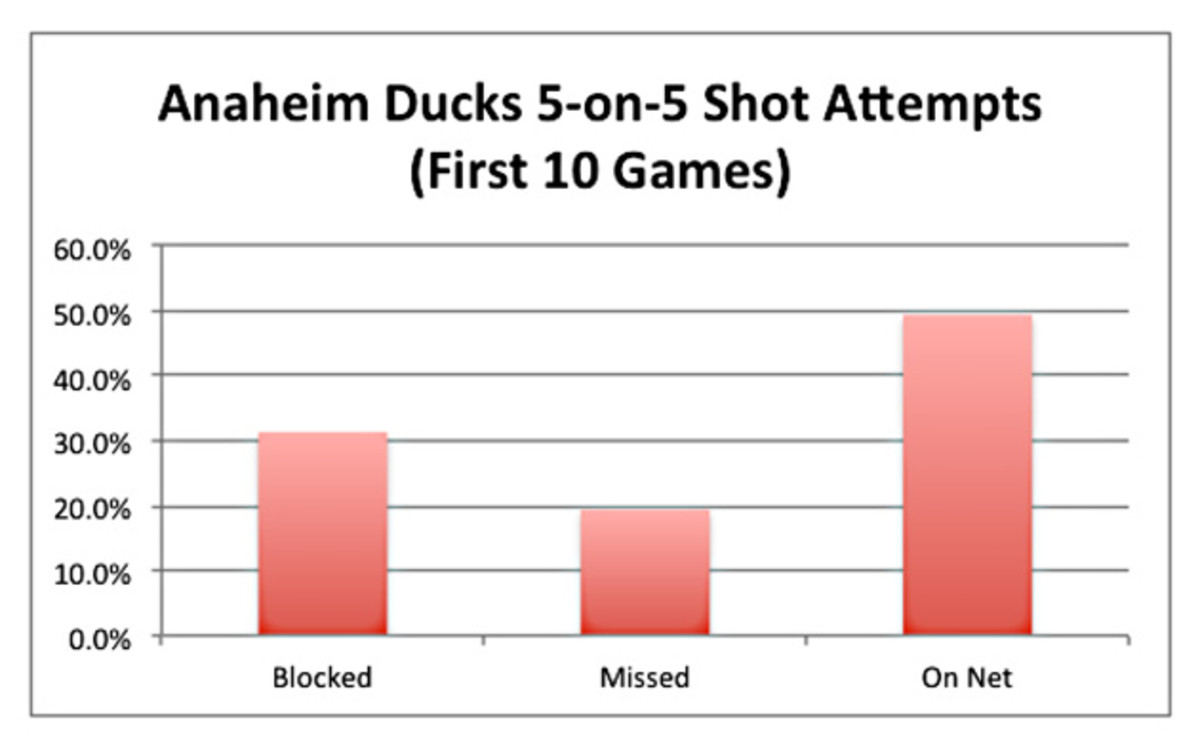
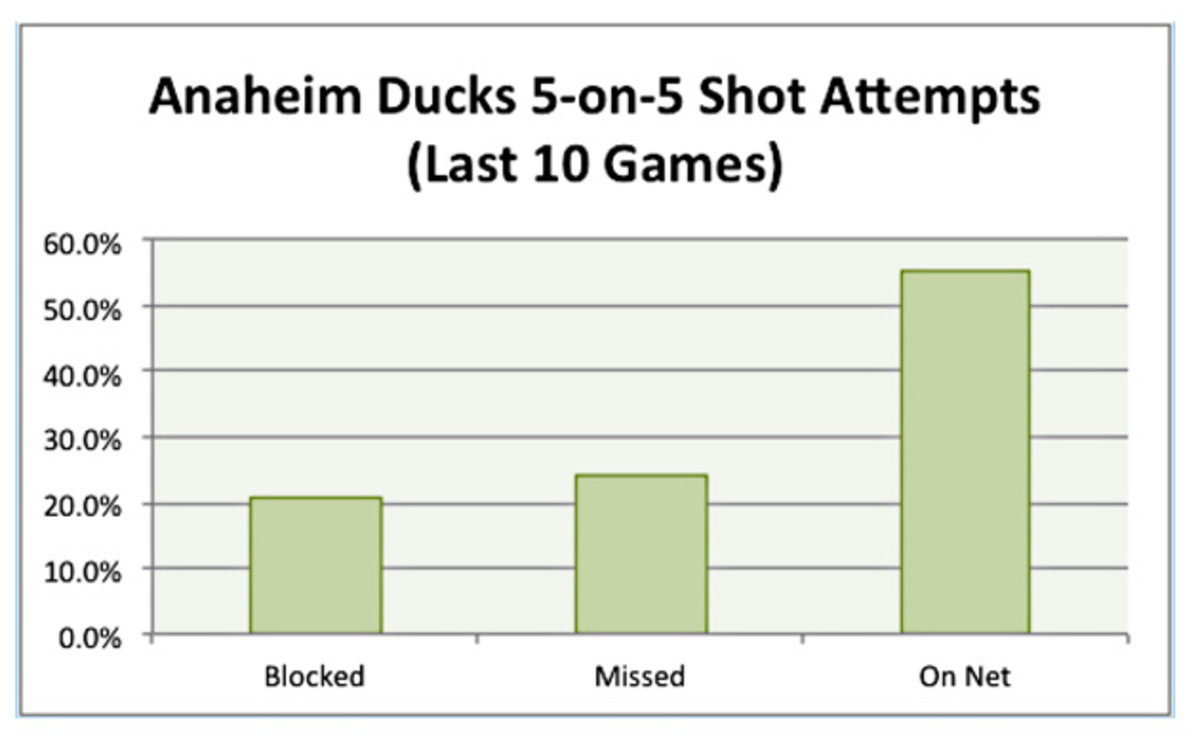
But is it REPEATABLE?
While it’s clear the Canadiens and Ducks have both won when they’ve gotten enough pucks on net and lost when they haven’t, all we’ve done so far is explained the past rather than what to expect going forward.
If teams aren’t able to get more pucks on net on a consistent basis, the insights above aren’t terribly useful.
This ability to do something consistently is referred to as “repeatability” and repeatability is the cornerstone of hockey analytics.
So, for example, analysts will acknowledge that an unusually high shooting percentage, save percentage or number of power play opportunities can all help a team win games. But all of these advantages are ephemeral. Eventually things are expected to settle to some average level and the team’s performance will decline accordingly.
This kind of thinking works pretty well on average. But as we noted last season, analysts’ hard and fast rules about what to expect from the average team can often miss some pretty important things.
Outliers matter.
The charts below show what happened during the previous two regular seasons (164 total games) for both the Ducks and Canadiens.
During that period, Anaheim registered 7,237 five-on-five shot attempts to Montreal’s 6,919.
But the Ducks didn’t just shoot the puck more, they also got it on net 53.0% of the time vs. Montreal’s 51.7%. Equally important, Anaheim managed a true shooting percentage (True Sh% measures five-on-five goals as a percentage of all five-on-five shot attempts, rather than only shots on goal) of 4.8% during that two-year period to Montreal’s 4.0%.
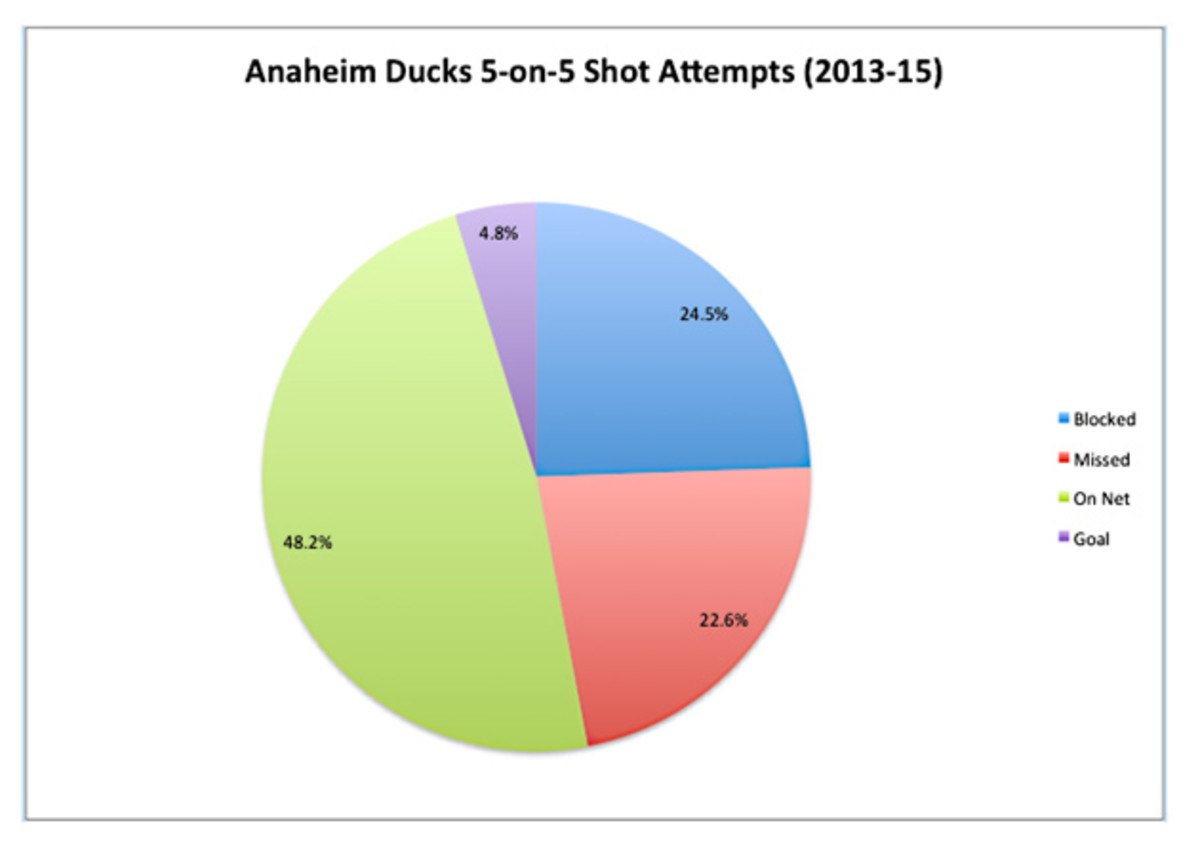
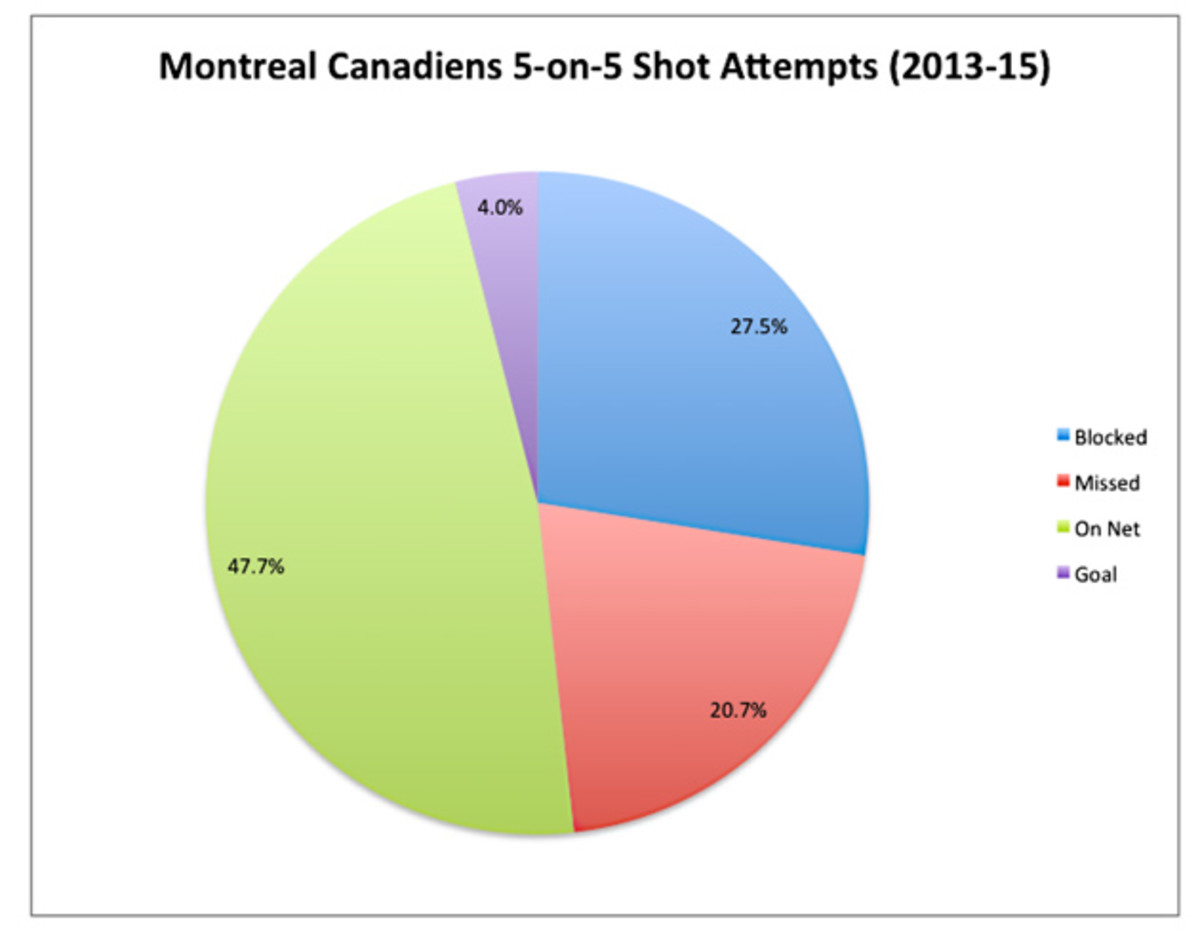
The differences here may not sound like much, but an increase in Montreal’s True Sh% to Anaheim’s level would have resulted in an additional 27 goals per season. In the case of last season, that would have raised Montreal’s total goals from 221 (18th overall) to 248, which would have been good enough for fifth.
This isn’t to suggest that Montreal can—or should—transform its game to become more “Duck like,” and it definitely doesn’t mean that getting shots on net is all that matters. We’re talking about a single indicator of shot quality, and there are surely others out there.
However, it’s clear that some teams may be able to give up the possession battle—to a point of course—if it is getting higher quality shots, and pucks on net is one indication that this is happening.
Because pucks on net is indeed a repeatable skill, it shouldn’t be overlooked (for those with lingering doubts, there’s a more detailed discussion and additional data on our blog.
Bold predictions for the second half of the 2015-16 NHL season
Hockey is an extremely complex game, so it shouldn’t be surprising to learn there isn’t a “one size fits all” strategy that maximizes shot attempts any more than there should be a single strategy that requires players to hold on to the puck while waiting for the perfect opportunity.
But understanding the mechanics of shot quality is undoubtedly the next great frontier in hockey analytics.
As for what to expect of the Habs and Ducks going forward, it’s worth noting that during its first 10 games Montreal posted a True Sh% of 5.0%, and 2.4% in its 10 before the All Star break. Which is to say early on that the Habs were scoring at an unsustainable pace, but fans should expect an improvement from their most recent dismal stretch.
Meanwhile the Ducks started the season with an utterly grotesque True Sh% of 1.4% and were trending at 4.6% at the break, meaning they were not far off their long term average with some modest room for improvement.
We’ll go out on a limb and assume the ship has been righted in Anaheim and that this is a team that, while not infallible, won’t be on other playoff clubs’ wish lists if they can grab a top three spot in the weak Pacific Division.
The Department of Hockey Analytics employs advanced statistical methods and innovative approaches to better understand the game of hockey. Its three founders are Ian Cooper (@ian_doha), a lawyer, former player agent and Wharton Business School graduate; Dr. Phil Curry (@phil_doha), a professor of economics at the University of Waterloo; and IJay Palansky (@ijay_doha), a litigator at the law firm of Armstrong Teasdale, former high-stakes professional poker player, and Harvard Law School graduate. Visit us on line at www.depthockeyanalytics.com
